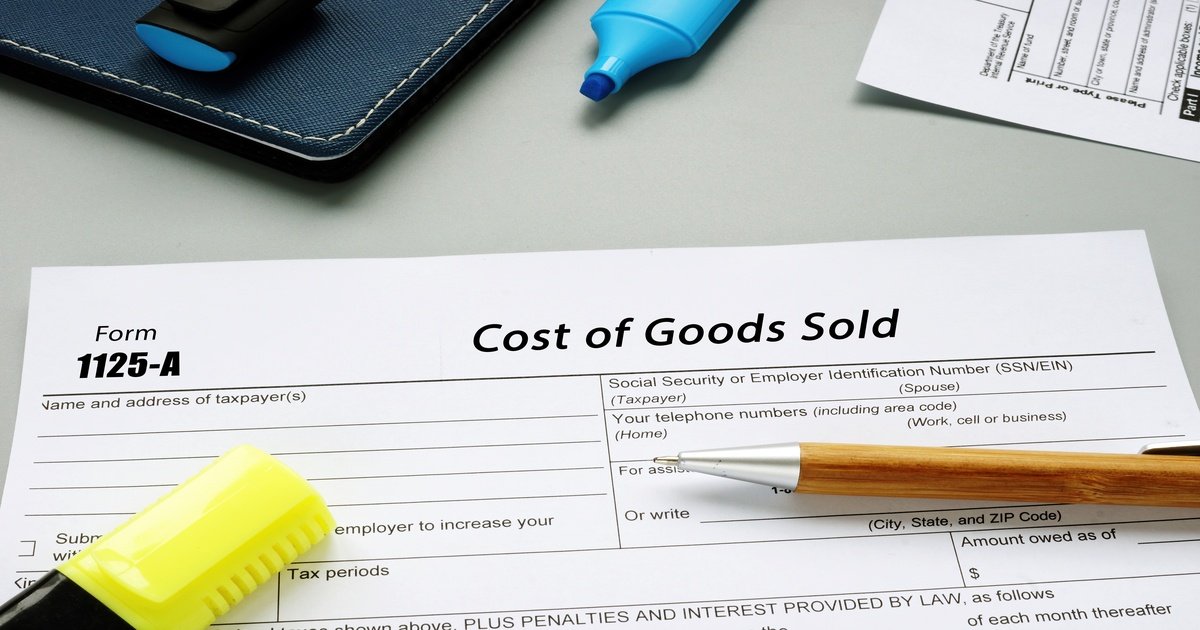Cost of Goods Sold (COGS)
The Cost of Goods Sold, or COGS, is a figure that represents what it costs a company to produce or acquire its goods or services.
COGS can be calculated by taking the inventory at the start of a period, adding purchases, and then subtracting the amount of inventory at the end of the period.
COGS = beginning inventory + purchases – ending inventory
The cost of goods sold is one of the biggest expense items for most companies. Companies that sell a service, rather than a good, often use the cost of sales or cost of revenue instead.
Below is a detailed overview of COGS, including what it is, which items are included, how to calculate COGS, uses, and limitations.
What is COGS?

The Cost of Goods Sold, or COGS, is the sum of the direct — mainly variable, but also some fixed — costs incurred to produce or acquire the goods that a company sells.
For example, COGS includes the following:
- Costs and transportation of raw materials
- Factory overheads
- Direct labor costs
- Utilities
- Storage costs for manufactured goods
Notably, it does not include the following:
- Distribution costs
- Administrative costs
- Marketing expenses
- Sales costs
- Indirect labor costs
Items like rent are normally included instead in operating expenses since the building is rented regardless of whether the goods are produced and sold.
The profitability of the company's core operations, or gross profit, can be found by subtracting the COGS from revenue.
However, this number doesn't consider how longer-term, multi-year expenses — like investing in new machinery, capital structure, or tax — are affecting profitability.
Additionally, service companies tend to use the cost of sales or the cost of revenue instead of COGS, as they don't sell actual goods.
What should be included in COGS?
If you're unsure which costs to include in COGS, keep in mind that the basic idea is to consider whether the cost would exist if the product hadn't been produced.
So, for a factory producing sausage rolls, factory overheads would be included, whereas office rent for administrative staff would not.
Importantly, COGS only includes the costs of goods that have actually been sold, meaning they've generated revenue during a specific time period. This is because COGS is a cost of doing business, so can be deducted as a business expense from the revenue it generates.
For this reason, inventory accounting methods are a critical component of COGS.
Understanding what COGS doesn't include is harder. On a high level, it does not include overhead costs like management, distribution, marketing, and sales.
COGS also does not include any inventory that has been manufactured or acquired but not yet sold, since these items have not contributed to revenue.
Where can you find COGS?
COGS is located near the top of the income statement. It's normally shown directly under revenue.
As it is not an asset or a liability, it's on the income statement and not the balance sheet.
SummaryCOGS represents the costs required to produce the goods a company sells. Examples include overhead costs, labor, storage, and utilities. COGS only includes the costs of goods that have been sold, thereby contributing to revenue.
How is COGS calculated?
Here's the formula for calculating the COGS:
COGS = beginning inventory + purchases – ending inventory
Purchases represent any direct costs incurred during the period, meaning costs related to making the product or service. Calculating inventory is slightly more complicated.
Inventory calculation methods
COGS should only include the costs of producing goods or services that have actually been sold. This means that accounting for inventory is a crucial component of COGS.
Inventory can be calculated via four methods. Understanding these is important, so you can get a clearer picture of what's really going on with inventory.
From their perspective, companies generally have an incentive to minimize their COGS, as this will help gross profit to be higher and encourage investors.
Here are the four accounting methods for calculating inventory:
| Method | Definition | Impact |
| FIFO (First In, First Out) | The earliest goods to be purchased or manufactured are the first sold. | As costs are likely to rise over the time period, COGS will be lower, so net income will likely increase over time.* |
| LIFO (Last In, Last Out) | The latest goods to be purchased or manufactured are the first to be sold. | As costs are likely to rise over the time period, COGS will be higher, so net income will likely decrease over time.* |
| Average cost | The average price of all goods sold during the period is used for COGS. | COGS is smoothed out, thus the effect of rising prices is dampened and net income over time is less affected. |
| Special identification | The actual cost of each individual item is used for COGS. Each is then recorded as sold or still in inventory. | This method is used by companies that sell unique items, like classic cars or art. |
*In a normal, inflationary environment, where all else remains equal.
The downside of FIFO is that, in times of high inflation, it can show higher profits which may not exist outside of the accounting methodology and will have to be resolved at some point.
Furthermore, companies have to pay taxes on their earnings, so if they misuse FIFO, they will end up paying taxes on “paper” or “accounting only” profits, resulting in a higher tax bill.
SummaryThe formula for COGS = beginning inventory + purchases – ending inventory. Inventory, however, can be calculated in one of four ways.
What are the different types of costs?
As the C in COGS represents, this term is about costs.
It's helpful to know that in accounting, there are many types of costs incurred by companies. These are split into categories, with some costs falling into several classifications.
For example, a cost could be both variable and direct, like the flour used to produce bread.
Here's a quick overview of the main types of costs:
- Fixed costs: These are costs that don't change, no matter how much of a product or service is being produced. An example is factory rent.
- Variable costs: These are costs that do change, depending on production volumes. Examples include shipping costs or the raw materials used to make something.
- Direct costs: Costs that are directly related to making a product or service.
- Indirect costs: These are all the other costs.
- Operating expenses: These are costs not directly linked to the production of revenue. Examples include rent, sales, marketing, insurance premiums, and legal costs.
When calculating COGS, operating expenses are the “other” costs not included.
SummaryIn accounting, there are many types of costs. The main types of costs are fixed, variable, direct, and indirect, as well as operating expenses. When calculating COGS, operating expenses are the “other” costs not included.
Why is COGS useful?
Since COGS is the direct cost of creating revenue from core operations, it helps indicate how efficiently a company is managing the costs that go into generating its core product or service.
However, knowing exactly what's been included in COGS can be less transparent than other reported numbers, so ensuring consistent reporting is key.
Nevertheless, COGS is a useful metric for both companies and investors.
Companies need to understand what it costs them to produce their goods so that they can strive for better raw materials pricing and set prices that give them competitive profit margins.
Additionally, investors want to see costs controlled, as a way of knowing that management is working efficiently to protect bottom-line profits.
SummaryCOGS helps indicate how well a company is generating profit from its core business. It can also help companies evaluate their costs, such as materials, and set prices that yield strong profit margins.
What are the limitations of COGS?
The main issue with COGS is that it can be easily manipulated by companies.
This is because it's hard for external parties, like investors or tax authorities, to check inventories and direct costs.
Items that can be altered rather easily can be used to, for example, overvalue inventory by changing the quantity in stock at the start or end of the period, inflating manufacturing costs, not writing off obsolete goods, or overstating returns and discounts.
In reporting a lower COGS, the company's profits will be inflated and its performance will look better than it actually is.
It's a good idea to dig into the numbers used to calculate COGS, to ensure all is as it seems.
SummaryThe primary downside of COGS is that it can be easily manipulated. It's hard to check inventory numbers, for example, and a lower COGS can inflate profits.
How do service companies calculate costs?
Companies that sell services use either the cost of revenue or the cost of sales to account for the expenses incurred while creating their offering.
The biggest difference between these two calculations is that cost of revenue also includes costs beyond the scope of production, such as marketing and distribution.
Examples of service companies include consultancies, dentists, hotels, painters, etc.
Since no goods are produced, the concept of COGS is translated a little differently but amounts to the same idea — that is, what it costs to be able to offer the service.
Service companies' main costs are usually direct labor, such as the cost of a consultant's time when working on a project.
However, they may also include travel costs and any sales commissions, etc.
SummaryCompanies that sell services instead of goods can use either the cost of revenue or the cost of sales when calculating what it costs to offer their service.
The takeaway
COGS represents the costs a company incurs to produce or acquire its goods and services.
As a way to measure costs, COGS is a useful number for both companies and their investors to know. Yet although a simple concept, it can be fairly easily manipulated depending on what is included and how it's accounted for.
For this reason, investors are encouraged to look more closely at the details behind the calculation and to ensure consistency with the accounting methods used.
This includes considering why a company has chosen a particular accounting method, as well as how that will affect gross profit.
At the end of the day, COGS is a useful part of the formula when evaluating a company, but should be considered alongside other metrics to paint a larger picture.





